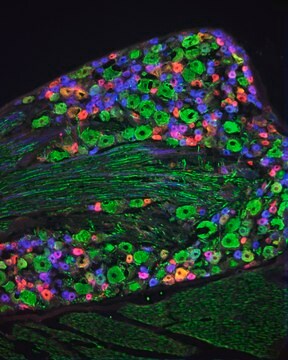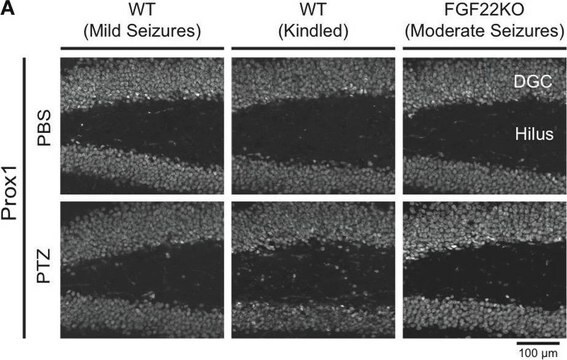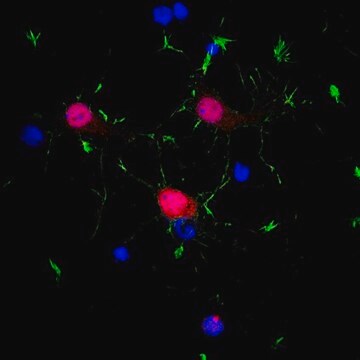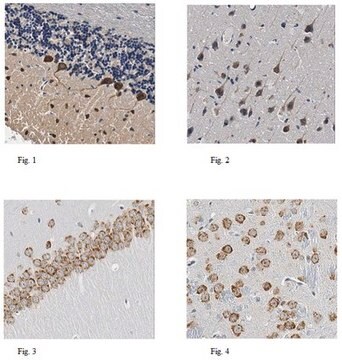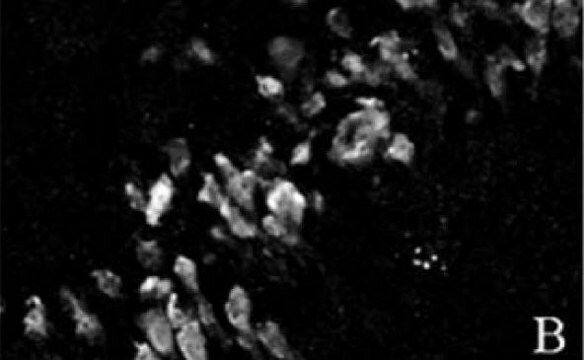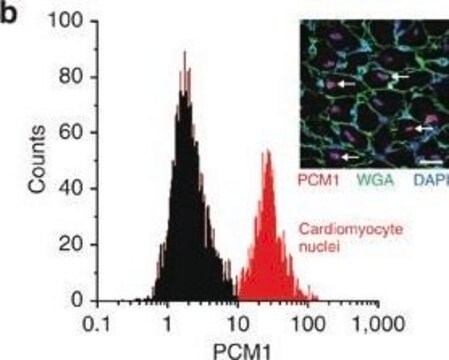MAB5266
Anti-Neurofilament H (200 kDa) Antibody
CHEMICON®, mouse monoclonal, N52
Synonym(e):
Anti-CMT2CC, Anti-NFH
About This Item
Empfohlene Produkte
product name
Anti-Neurofilament 200 kDa Antibody, clone N52, clone N52, Chemicon®, from mouse
Biologische Quelle
mouse
Qualitätsniveau
100
300
Antikörperform
purified immunoglobulin
Antikörper-Produkttyp
primary antibodies
Klon
N52, monoclonal
Speziesreaktivität
human, mouse, monkey, rat, pig
Hersteller/Markenname
Chemicon®
Methode(n)
immunohistochemistry: suitable
western blot: suitable
Isotyp
IgG1
NCBI-Hinterlegungsnummer
UniProt-Hinterlegungsnummer
Versandbedingung
wet ice
Posttranslationale Modifikation Target
unmodified
Angaben zum Gen
human ... NEFH(4744)
mouse ... Nefh(380684)
pig ... Nefh(100156492)
rat ... Nefh(24587)
rhesus monkey ... Nefh(717705)
Allgemeine Beschreibung
Spezifität
Immunogen
Anwendung
Neurowissenschaft
Neurofilament & Neuronen-Stoffwechsel
Neuronen- & Gliamarker
Immunohistochemistry: 5-10 μg/mL
Optimal working dilutions must be determined by end user.
Immunohistochemistry: Antibody N52 reacts with a fragment of NF-200 side-arm that is located at the end of the MPR KSP domain and which contains the consensus cdk-5 phosphorylation site, however this reactivity is abolished if the NF-200 fragment becomes phosphorylated by cdk-5 {Guidato et al, 1996}. Thus for the fullest staining and reactivity, including westerns, it is suggested that samples be treated with alkaline phosphatase prior to antibody staining. The following treatment protocol is suggested:
ProtocolPreparation of Solutions:
I. TBS: Tris-HCl, 0.1 mol/l; NaCl, 0.1 mol/l′ pH 8.0.
II. Mix alkaline phosphatase, 1 mg/ml with 1 mol/l ZnSO4,; 1mol/l MgCl2, and 1mmol/l PMSF; and dissove in TBS.
NOTE: It is necessary to dialyze the alkaline phosphatase against solution I before use.
Procedure:
Frozen sections from shock frozen tissue samples are air-dried and then fixed with acetone for 10 min at -20°C. The excess acetone is allowed to evaporate at room temperature. Incubate the sections in solutions II for 4 hours at +30oC and wash in TBS 3 times for 5 minutes each. Negative control sections are incubated in solution II with out alkaline phosphatase. Further treatment as follows:
- Cover the preparation with 10-20 μl antibody solution and incubate for 1 hr in a humid chamber.
- Immerse the slide in TBS and wash in TBS 3 times for 5 minutes each.
- Cover the preparation with 10-20 μl of a solution of anti-mouse Ig-antibody, labeled with fluorscine isothiocyanate, and incubate in a humid chamber at 37°C for 1 hour.
- Wash the slide in TBS 3 times for 5 min each.
Physikalische Form
Lagerung und Haltbarkeit
Sonstige Hinweise
Rechtliche Hinweise
Haftungsausschluss
Sie haben nicht das passende Produkt gefunden?
Probieren Sie unser Produkt-Auswahlhilfe. aus.
Empfehlung
Lagerklassenschlüssel
10 - Combustible liquids
WGK
WGK 2
Flammpunkt (°F)
Not applicable
Flammpunkt (°C)
Not applicable
Analysenzertifikate (COA)
Suchen Sie nach Analysenzertifikate (COA), indem Sie die Lot-/Chargennummer des Produkts eingeben. Lot- und Chargennummern sind auf dem Produktetikett hinter den Wörtern ‘Lot’ oder ‘Batch’ (Lot oder Charge) zu finden.
Besitzen Sie dieses Produkt bereits?
In der Dokumentenbibliothek finden Sie die Dokumentation zu den Produkten, die Sie kürzlich erworben haben.
Kunden haben sich ebenfalls angesehen
Unser Team von Wissenschaftlern verfügt über Erfahrung in allen Forschungsbereichen einschließlich Life Science, Materialwissenschaften, chemischer Synthese, Chromatographie, Analytik und vielen mehr..
Setzen Sie sich mit dem technischen Dienst in Verbindung.